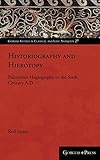Historiography and Hierotopy : Palestinian Hagiography in the Sixth Century A.D. / Rod Stearn.
Material type: TextSeries: Gorgias Studies in Classical and Late Antiquity ; 27Publisher: Piscataway, NJ : Gorgias Press, [2020]Copyright date: ©2020Description: 1 online resource (367 p.)Content type:
TextSeries: Gorgias Studies in Classical and Late Antiquity ; 27Publisher: Piscataway, NJ : Gorgias Press, [2020]Copyright date: ©2020Description: 1 online resource (367 p.)Content type: - 9781463239817
- 9781463239824
- Christian hagiography -- History -- To 1500
- Christian saints -- Byzantine Empire -- Biography -- History and criticism
- Christian saints -- Byzantine Empire -- Biography -- History and criticism
- Christian saints -- Judaea, Wilderness of -- Biography -- History and criticism
- Christian saints -- Judaea, Wilderness of -- Biography -- History and criticism
- Christian saints -- Palestine -- Biography -- History and criticism
- Christian saints -- Palestine -- Biography -- History and criticism
- Monastic and religious life -- History -- Early church, ca. 30-600
- Monastic and religious life -- Judaea, Wilderness of
- Monastic and religious life -- Palestine
- Antiquities & Archaeology
- Religion
- RELIGION / Antiquities & Archaeology
- 200.9 22
- online - DeGruyter
| Item type | Current library | Call number | URL | Status | Notes | Barcode | |
|---|---|---|---|---|---|---|---|
 eBook
eBook
|
Biblioteca "Angelicum" Pont. Univ. S.Tommaso d'Aquino Nuvola online | online - DeGruyter (Browse shelf(Opens below)) | Online access | Not for loan (Accesso limitato) | Accesso per gli utenti autorizzati / Access for authorized users | (dgr)9781463239824 |
Frontmatter -- TABLE OF CONTENTS -- ACKNOWLEDGMENTS -- ABBREVIATIONS -- INTRODUCTION -- PART I: NETWORKS AND INSTITUTIONS -- CHAPTER 1. AN EVOLVING ENVIRONMENT -- CHAPTER 2. EUTHYMIANS -- CHAPTER 3. SABAITES -- CHAPTER 4. CIVIL WAR -- PART II: NARRATIVES -- CHAPTER 5. CONTEXTUALIZING DEFEAT -- CHAPTER 6. RESPONDING TO CHANGE -- CHAPTER 7. CYRIL OF SCYTHOPOLIS -- EPILOGUE -- BIBLIOGRAPHY -- INDICES
restricted access online access with authorization star
http://purl.org/coar/access_right/c_16ec
Judean hagiographies are unusual. Some surprise in their structure, resembling historical chronicles more than "traditional" hagiographies. Others offer unexpected content, running counter to the stylizations of their time. The peculiarities of these works have often been examined on literary and theological grounds. It is the unmined implications of their socio-economic context, however, that provide new perspectives on the works' unique qualities. The local and imperial connections of the saints, the networks they constructed, and the institutional realities of the monasteries they founded shine new light on Judean texts. The search for this formative context leads the reader through the patronage networks of Jerusalem, Constantinople, and Rome. It moves from the quiet desert to the bustling halls of power, and from anchoritic cells to ecumenical councils. It navigates ecclesiastical factions of Syriac, Greek, and Latin connection, and negotiates the economics of Holy Land pilgrimage. Circling back to examine the hagiographers themselves in a new way, the search provides new answers to an old question: why are Judean hagiographies so unusual? This approach firmly links the works to their institutions, and envisions them as the textual element of larger hierotopic constructions.
Mode of access: Internet via World Wide Web.
In English.
Description based on online resource; title from PDF title page (publisher's Web site, viewed 27. Jan 2023)


